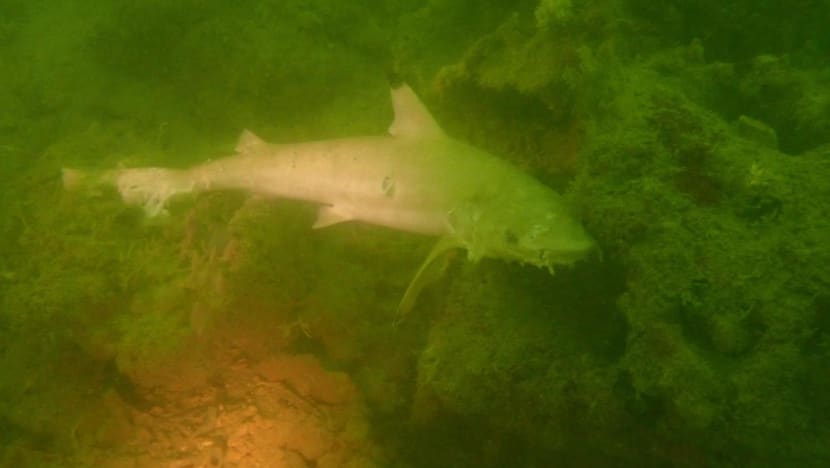Commentary: Dead sharks in discarded fishing nets – the issue runs deep in Singapore’s waters
Blacktip reef sharks and other marine organisms are often victims of abandoned, lost or discarded fishing gear in Singapore, with certain kinds of equipment being more destructive than others, says NUS researcher Anya Gajanur.

One of the dead blacktip sharks found in the waters off Pulau Hantu. (Photo: Facebook/Marine Stewards)
SINGAPORE: Last August, photos of dead juvenile blacktip reef sharks in waters off Pulau Hantu made the rounds online. The sharks likely died after being trapped in a gill net, which indiscriminately entangles any marine organism unable to pass through the mesh.
Found on or near Singapore’s reefs, blacktip reef sharks are shy and skittish. They rarely interact with or have any interest in humans. They play an important part in maintaining the populations of reef and intertidal areas, allowing biodiversity to thrive.
But they are often victims of abandoned, lost or discarded fishing gear (ALDFG) in Singapore.
The August incident at Pulau Hantu is not the first or only time sharks, especially juveniles, have been harmed by discarded nets. In 2015, 13 juvenile reef sharks, in addition to 28 other marine species, were found in a driftnet off Lazarus Island. In 2021, 12 juveniles were found entangled and dead in an abandoned gill net at Pulau Semakau.
To reduce such occurrences, net fishing is prohibited in areas managed by the National Parks Board (NParks). NParks encourages the use of hook-and-line over nets as it targets specific fishes, and also allows fishers to practice catch-and-release methods.
NEGATIVE EFFECTS OF GILL NETS
In Singapore, the most used equipment is fishing line, followed by gill nets. The documented negative effects of gill nets are worrying.
Chief among them is bycatch – non-target organisms caught in fishing gear. Even if an animal is alive when released from the gear, they often end up with injuries from handling that lead to death.
Listen to CNA938's XX Files: Conserving marine life
This is likely what happened to the juvenile sharks at Pulau Hantu – fisherman may have tried to free the entangled individuals from the gill net, but the sharks were hurt in the process and eventually died.
The impact of ALDFG has been well-documented elsewhere, but only recently has the extent of the problem been quantified in Singapore. From 2000 to 2019, nearly 25,000 instances of ALDFG have been recorded in Singapore, with fishing lines and nets comprising 37 per cent and 34 per cent of the dataset respectively.
Even after being lost, relatively intact fishing gear continues to do what it does best – catch or trap marine creatures. This issue is also termed “ghost fishing”. The nets will continue to entangle marine organisms until they disintegrate, but that can take months or years.
Moreover, as a fishing gear disintegrates in the water, it releases microplastics. Besides the negative effects of microplastics on marine and freshwater organisms, such as delaying growth and shortening life spans, there could be health implications for people who consume them in turn.
While it’s not possible to pinpoint the source of ALDFG, the majority of lines and some nets found in Singapore were most likely first used in our own shorelines and waters.
MINIMISING DESTRUCTIVE FISHING PRACTICES
As fishing continues to rise in popularity, the use of more destructive fishing gears needs to be heavily monitored or even restricted.
As things stand now, there is limited legal protection for vulnerable species and juvenile fishes. Although NParks recommends practicing catch-and-release, it is difficult to enforce this practice among recreational fishers.
Furthermore, certain types of fishing gear, namely gill nets, drift nets and long-line fishing, can damage the ecosystem more than others.
Restrictions on destructive gear can be effective in causing populations of fishes (including sharks) and marine mammals to rebound.
In 2017, Mexico issued a ban on gillnets to protect the critically endangered vaquita, a small porpoise whose population has dropped to as few as 10 individuals. Mexican authorities hope that banning gill nets will help bring vaquitas back from the brink of extinction.
The California large-mesh drift net ban was passed in 2020 after studies showed that replacing drift nets with deep-set buoy gear significantly reduced bycatch.
Controlling gill net mesh size is also another alternative. The Australian Sea Lion Management Strategy regulates mesh size so that juveniles and undersized sharks can pass through while large adult sharks bounce off the net. This ensures that the population of breeding sharks always remains stable in the waters.
Much of the challenge remains in passing legislation. In other countries where such laws are enacted, lucrative commercial fisheries had lobbied against these laws.
But with Singapore’s fishing efforts coming mostly from recreational communities, there is still hope that we may be able to conserve our marine habitats. There may be pushback, but it is not an impossible task if we pursue respectful and data-backed discourse with all stakeholders.
STOPGAP MEASURES AGAINST NET FISHING
While a ban on selling and using gill nets is much needed in this sphere, it will take a long time to pass legislation and establish enforcement.
At the same, as we work towards integrating this new understanding of harmful fishing practices and conservation of biodiversity into our legislation, we need to prevent destructive fishing practices in the short term.
This could take the form of improving our collective understanding of the consequences of destructive fishing practices.
Government agencies and non-profits could host events to raise awareness and initiate drives for more volunteers, so more are invested in the conservation of marine biodiversity. They could also work towards disseminating a layman protocol for the safe disentanglement of bycatch and live animals trapped in ALDFG.
Anya Gajanur is a Teaching Assistant at the Department of Biological Sciences, National University of Singapore.




















